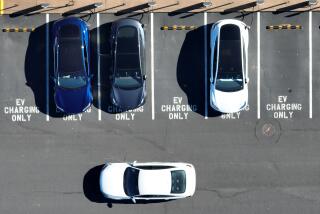Garia LSV offers electric luxury at 25 mph
As gas prices escalate toward $5 a gallon, one novel fuel saver is generally overlooked: the street-legal golf cart.
These electric, low-speed vehicles, or LSVs, have been available since 1998 but have yet to catch on with urban commuters who may not be keen to avoid freeways and chug along at 25 mph.
LSVs are essentially golf carts equipped with seatbelts, a safety-glass windshield and other street-legal features required by the National Highway Traffic Safety Administration. Driving one requires all the same things as a car: registration, insurance and a valid license.
It just doesn’t take as much money.
Spurred by a 10% federal tax credit on the new-vehicle purchase price, several golf cart manufacturers have recently transformed their two- and four-passenger vehicles from products that were designed to roll through expanses of well-groomed grass into mini cars to trek the urban wilds.
Georgia-based golf cart manufacturers Club Car and E-Z-Go have added street-legal products to their golf cart lineups in the last 18 months; prices start around $9,000. Now the luxury brand Garia has followed. The Garia LSV starts at $14,500 and is available at golf cart and electric car dealerships.
Driving a souped-up golf cart on Los Angeles streets is not for the faint of heart. LSVs are best in light traffic, and even then, they require hyper-vigilance behind the wheel. The Insurance Institute for Highway Safety has raised concerns about the safety of low-speed vehicles if they crash.
Garia is a little-known Danish manufacturer of elite golf carts that will appeal to drivers who value emission-free economy, European style and a performance pedigree. Garia isn’t a household name, but its affiliates make for good name-dropping.
Garia says its LSVs are manufactured at the same Finnish factory where, up to last month, the Porsche Boxster and Cayman had been produced since 1997. Its aluminum frame pieces are made by the same company that supplies them to luxury automakers Aston Martin, Jaguar and Volvo. Even components of its drivetrain are built by the same firm that provides transmissions to Ducati — the Italian sport bike maker.
Snub-nosed yet elegant, with hand-stitched leather seats that complement a muted palette of exterior colors, the Garia is Pebble Beach for the street.
I’m not a golfer, so I didn’t wheel the Garia onto the fairway, even though it can also be driven there. I’m a commuter who wanted to know how the Garia compared with my review roster of mostly gas-powered vehicles.
One of the biggest differences was attention, mostly in the form of stares, smiles and strangers asking, “Is that legal?”
In the week I drove the Garia around L.A., I found the ride refreshing, and not only because it lacks doors. The Garia uses many automotive components that make it handle more like a car than a golf cart, and its electric powertrain is centered and low, also improving handling.
Powered with an eight-kilowatt-hour lead-acid battery pack and 4-horsepower AC motor, the Garia had excellent off-the-line acceleration. In traffic, I was routinely able to jump out ahead of other cars once the light turned green.
Unfortunately, those cars easily caught up and passed me because LSVs are legally, and technologically, limited to a maximum speed of 25 mph. In California, like many states, LSVs can be legally driven on streets with posted speed limits up to 35 mph.
Coupling its acceleration with the independent double-wishbone suspension of its front end made its cornering impressive to me as a driver, but it was a bit scary for my 8-year-old, who, after I took a particularly fast turn, feared he’d be dumped in the intersection. I shared his concern.
The seat belts in the Garia lack a shoulder harness. At least there were hydraulic brakes on all four wheels, giving the Garia as much stop as its go.
The Garia is capable of traveling about 35 miles on a single charge. I got about two round-trip commutes out of each charge, or about 30 miles, before I felt compelled to plug in. Recharging takes about seven hours using a 110-volt outlet. I was able to fully recharge the Garia in the parking garage while at work for no charge.
Like a fuel gauge, the Garia’s electric charge status is highlighted on a small screen immediately behind the steering wheel. The display employs five lights — all of which glow when fully charged. As it is driven, the lights gradually disappear.
It isn’t the most precise system. Hills, in particular, throw it for a loop.
My son’s elementary school is at the top of a mile-long hill, which, even on a fresh charge, rapidly ran the lights down to red by the time I parked after only three miles of driving. It routinely turned out to be a false reading.
Like other electric vehicles, such as the Chevrolet Volt, the Garia LSV uses regenerative brakes that harness the kinetic energy when stopping and feed it back into the battery to extend its range.
It also has a hill-descent restraint that stops this 1,200-pound cart from careening out of control when heading downward, and an electromagnetic parking brake that stops the cart from slipping backward when stopped on an incline.
Still, there are some aspects of the Garia that could stand further refinement, such as the air scoop in the roof, which is designed to provide additional ventilation in this already ventilated cabin.
The handle holding the air scoop in place jiggled free almost every time I drove over anything bumpy, which, in potholed L.A., meant roughly every 30 seconds. I was constantly reaching up to secure it in place.
There’s a small amount of storage under the front hood, and a bin deep enough to hold groceries immediately behind the front bench seat. Future versions of the LSV will swap the bin for a rear-facing seat with storage under the cushions.
Even though I was testing the street-legal Garia, it was equipped with some unnecessary golf-cart holdovers, including a steering wheel clip to secure a score card and pen, a golf-ball holder in the dash, a mini-fridge and, of course, golf bag holders.
Together, they made me look like I’d taken a wrong turn out of Torrey Pines. Now, where did I put my plaid pants?






